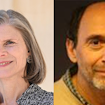Marc Kamionkowski, David Spergel Awarded 2015 Dannie Heineman Prize
On January 16, Marc Kamionkowski, a Simons Investigator in theoretical physics, and David Spergel were awarded the 2015 Dannie Heineman Prize for Astrophysics. The prize, awarded annually by the American Astronomical Society and the American Institute of Physics to mid-career scientists for outstanding work in astrophysics, is one of the most significant honors in the field.

Kamionkowski, professor of physics and astronomy at Johns Hopkins’ Krieger School of Arts and Sciences, and Spergel, the Charles A. Young Professor of Astronomy and chair of the astrophysical sciences department at Princeton University, received the prize in recognition of what the selection committee describes as their “outstanding contributions to the investigation of the fluctuations of the cosmic microwave background, which have led to major breakthroughs in our understanding of the universe.”
“All of the prior recipients of this prize are people whose work I have admired over the years, and so it’s a great honor to be included among them,” says Kamionkowski. “It’s also great to share the prize with David Spergel, an early mentor to me and a remarkable scientist.”
Kamionkowski began studying cosmic background radiation, or leftover thermal energy from the Big Bang, in the 1990s. Together with Spergel, he wrote several papers proposing a way to determine the spatial geometry of the universe from measurements of the way the temperature of the cosmic microwave background varies across the sky. These proposals provided the theoretical basis for a generation of remarkable experiments that have established our current understanding of the earliest moments of the universe. Later, Kamionkowski studied the polarization of the cosmic microwave background, providing impetus for experimental measurements of this phenomenon.
“I think the prize recognizes the tremendous advances that have occurred in cosmology in the past decade and a half through studies of the cosmic microwave background,” says Kamionkowski. “The takeaway message for me, as a theorist involved in this enterprise, is that there is value in thinking freely, unfettered by the limitations of current experiments, about what might be done in the future.”

David Spergel’s primary research focus over the last few years has been the Wilkinson Microwave Anisotropy Probe (WMAP), a NASA satellite launched in 2001 to make fundamental measurements of the cosmic microwave background in order to understand the properties of the universe as a whole. He also belongs to a group of scientists and engineers at Princeton who are developing new technologies that aim to enable direct imaging of Earth-like planets. His next major cosmic microwave background venture will be at the Atacama Cosmology Telescope (ACT), where he will work closely with experimentalists searching for cosmic signatures of the Big Bang.
“I was very pleased to receive the Heineman prize,” says Spergel. “I particularly want to thank my WMAP and ACT colleagues whose hard work and scientific vision enabled us to make precision measurements of the microwave background fluctuations. It has been great fun working with these data and understanding their implications for cosmology. The last two decades have been a very exciting time to be a cosmologist.”
The two winners will share a $10,000 prize and receive recognition for their work at an upcoming American Astronomical Society meeting.


